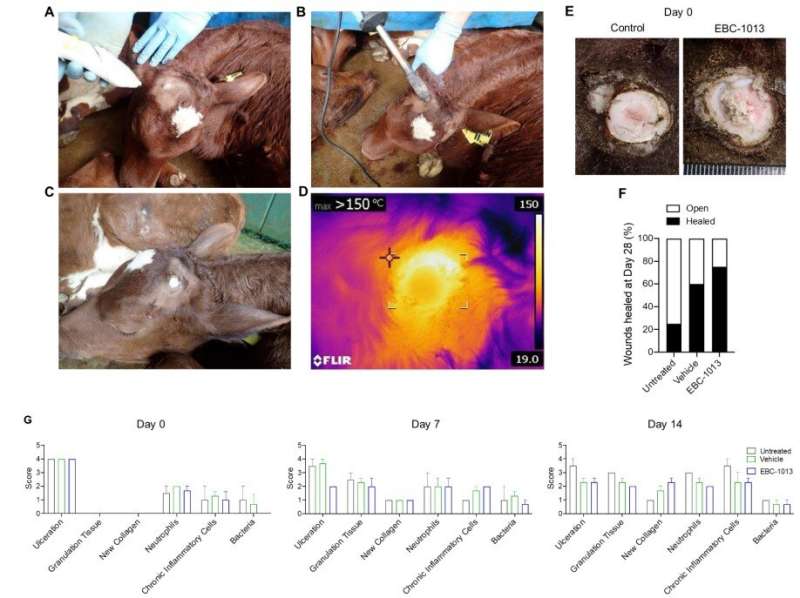EBC-1013 induced healing in acute thermal burn injury calf wound model. Photographs of (A) clipping of the hair, sedation and local anesthetic nerve block. (B and C) Calf disbudding using a disbudding iron (at 500℃) creating bilateral, full-thickness burn wounds. (D) Image of disbudding site immediately following removal of disbudding iron showing localized area of the burn. (E) Day 0 wound images +/- EBC-1013 treatment (3 mg/ml) in the calf wound model. (F) Percentage of wounds healed at day 28 within the calf wound model (n=12). (G) Histology scores from wound biopsies at day 0, 7 and 14 demonstrating ulceration, granulation tissue, new collagen, neutrophils, chronic inflammatory cells and bacteria. Data shown as mean ±SEM. Credit: Science Translational Medicine (2022). DOI: 10.1126/scitranslmed.abn3758
A team of researchers affiliated with multiple institutions in the U.K. and Australia has developed a nontraditional ointment to treat skin wound infections based on a molecule found in the sap of a Queensland blushwood tree. The study is published in the journal Science Translational Medicine.
Prior research (and anecdotal evidence) had shown that the Queensland blushwood tree has medicinal properties—its sap is currently being studied by another team to discover if it might help treat cancer patients. In this new effort, the researchers studied the sap and used it to make an ointment as a therapy for hard-to-treat open skin wounds.
Open skin wounds have become a major problem in recent years due to the large number of people living with diabetes. People with the disease have reduced blood flow to their feet, which makes them susceptible to chronic, nonhealing skin wounds. These wounds are particularly susceptible to bacterial infections that are hard to treat because the bacteria create films that block antibiotics. Also, medical scientists would prefer not to treat such infections with traditional antibiotics because it speeds up the rate at which they become immune to such therapies.
In this new effort, the researchers examined sap samples from the blushwood tree and identified a molecule that appeared to be a promising candidate to treat open wound bacterial infections. Called EBC-103, the molecule interferes with the structure of the biofilms, allowing the immune system to mount an attack. They also found that the molecule incited inflammation in the area where it was applied, which also helped with healing.
The researchers made an ointment using the molecule and applied it to calves with burn wounds resulting from horn removal. They found that not only did the ointment prevent bacterial infection, it also hastened healing—75% of the calves were fully healed after 28 days, compared to just 25% who went untreated.
More information: Lydia C. Powell et al, Topical, immunomodulatory epoxy-tiglianes induce biofilm disruption and healing in acute and chronic skin wounds, Science Translational Medicine (2022). DOI: 10.1126/scitranslmed.abn3758
Journal information: Science Translational Medicine
© 2022 Science X Network
























